PinotFile: 12.6 May 25, 2020
|
Recent Pinot Noir Wines I Have Enjoyed
2009 Rhys Horseshoe Vineyard Santa Cruz Mountains Pinot Noir 13.3% alc., $69. Rhys selections and two heritage clones of Pinot Noir planted in 2004 on 10.85 acres. The defining feature of this vineyard is its intensely rocky soil composed of sedimentary Monterey shale. Elevation is 1,400 to 1,600 feet. All Pinot Noir at Rhys is fermented with native yeast, and aging is carried our in the finest French oak barrels that have been air dried for four full years in Burgundy. The consistency of the barrels implies that the wines are differentiated entirely by the vineyard and not by the barrel. The Pinot Noir wines are typically aged 18 months in barrel. The wines are never fined or filtered. Note: Eleven years later, Horseshoe Vineyard is considered by the team at Rhys to be “one of the finest sites in California to grow Pinot Noir. The vineyard also produces Chardonnay that is “a stunning example of New World terroir….tremendously complex and invigorating wines. The 2018 vintage of Horseshoe Vineyard Pinot Noir and Chardonnay is now available as a futures order. Rhys wines are sold exclusively through a mailing list at www.rhysvineyards.com. The winery’s website is one of the most informative I have ever encountered. · Moderately dark garnet color in the glass. The nose offers aromas of dark berries and cassis with a floral element prominent. The mid weight flavors of blackberry and black cherry are graciously in harmony with the wine’s lacy tannins and steely acidity. This wine is now drinking at its peak and it was only by fate that I decided to open the bottle at its apogee. I wish I had more. Score: 95
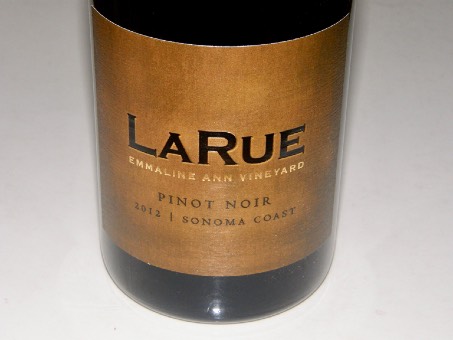 2012 LaRue Emmaline Ann Vineyard, Sonoma Coast Pinot Noir 12.4% alc., 50 cases, $70. Sourced from a 3-acre vineyard near the town of Freestone. Dijon clones planted in Goldridge sandy loam soil. Aged 17 months in 50% new French oak barrels. Note: LaRue wines are sold by owner and winemaker Katy Wilson through a mailing list at www.laruewines.com. · Moderately light garnet color in the glass. A feminine wine that has held up beautifully over time. Despite its relatively light color and lighter body, this wine delivers plenty of deep aromas and flavors of cherry, raspberry, blueberry and spice. There is a vein of whole cluster goodness running through. A silky mouthfeel benefits from gossamer tannins. Still refined and classy as I noted in my December 10, 2014 review and drinking at its peak now. Rated 94 previously and still Score: 94
2015 Press Cellars Helluva Vineyard Anderson Valley Pinot Noir 13.9% alc., 300 cases, $25. (Just being released currently). Wine buyer and retailer Patrick Campbell crafts a Howell Mountain Cabernet Sauvignon and an Anderson Valley Pinot Noir from Helluva Vineyard, 5.5 acres located near Boonville. I scored this wine 93 and it is now sold out. The winery is owned by three families from San Diego: Campbells, McDonalds and Giboneys. Smith Story Wine Cellars, Betwixt Wines and Handley Cellars have bottled vineyard-designated wines from this vineyard. Pommard 5 clone. Aged 11 months in French oak barrels, 60% new. www.presscellars.com. · Dark garnet color in the glass. This wine offers the typical black cherry fruit aromas and flavors of the Pommard clone. Bombastic in style, with well incorporated oak seasoning and agreeable tannins, finishing with a satisfying black cherry cordial finish. This beauty reminds me of a typical Russian River Valley Pommard-based, wellripened Pinot Noir such as those produced at J. Rochioli. The price is not a misprint! Score: 92
2016 Fulcrum Gap’s Crown Vineyard Petaluma Gap Pinot Noir 14.3% alc., 224 cases, $68. Clones “faux 828,” and 667. Aged 11 months in French oak barrels, 40% new. Bottled unfined and unfiltered. Note: I have been following and reviewing the wines of David Rossi since 2006 and have seen a recognizable rise in quality. The Gap’s Crown Vineyard bottling is deserving of the most accolades year in and year out. Interestingly, David lives in New Jersey and travels back and forth for winemaking operations and sales events. The coronavirus has slowed, yet not stopped him. He continues to pay his employees through the shutdown. He says, “We will not let some virus take us out. As soon as it is safe to open, we will open the doors.” Fulcrum’s tasting room is located on the Sonoma Plaza. The wines are also sold through a mailing list at www.fulcrumwines.com. · Moderately dark garnet color in the glass. Generous aromas of blueberry, blackberry jam, and spice. Very seductive on the palate, with a silken texture and a long, deep core of purple and black fruits that caress the palate. Evocative harmony with a lasting finish of vibrant fruitiness. Previously rated 97 when reviewed April 14, 2018, and still pumping out the glorious Pinot charm. Score: 97
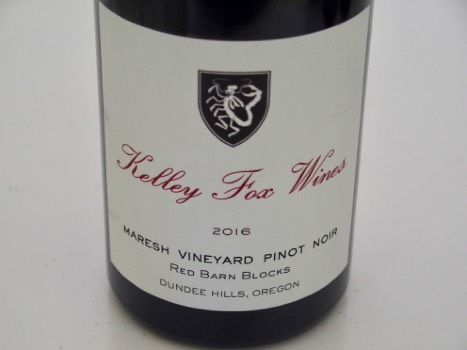 2016 Kelley Fox Wines Maresh Vineyard Red Barn Blocks Dundee Hills Willamette Valley Pinot Noir 13.0% alc., 46 cases, $75. Grapes were sourced from the original 1970 plantings of Wädenswil and Pommard clones surrounding the Maresh Red Barn. Maresh is the 5th oldest vineyard in Oregon and is farmed by Jim and Loie Maresh. Kelley was formerly the winemaker for Scott Paul for ten years . Her long-time personal relationships in the Willamette Valley allow her to source outstanding fruit from Maresh Vineyard, Hyland Vineyard and Momtazi Vineyard. This wine saw no new oak (as all Kelley Fox Pinot Noirs). Note: Four 2018 Maresh Vineyard Pinot Noirs are currently offered including three block-designates ($75-$100) at www.kelleyfoxwines.com. · Moderately light ruby red color in the glass. A very elegant, feminine wine with gracious aromas of red cherry, spice, sandalwood and thyme. Very silky and sexy on the palate with fresh flavors of red cherry and red currant. Impeccably balanced with a lasting finish. This wine is at a nadir now. Score: 95
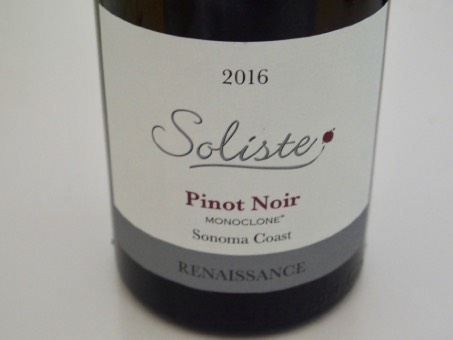 2016 Soliste Renaissance Sonoma Coast Pinot Noir 13.1% alc., 45 cases, $85 ( available by allocation). The goal at Soliste is to focus on each specific clone of Pinot Noir that is best in harmony with each vineyard site: Single Vineyard, Single Clone, and Single Cooperage wines - Monoclone®. Claude Koeberle and Don Plumley have the dream to be in the conversation with the legendary Burgundies because they are the benchmarks that inspire and drive their madness. They feel that the 2016 vintage Soliste Pinot Noir wines are the most Burgundian of all the vintages produced to date. This wine is from The Sonatera Vineyard, specifically a few rows of vines that allowed to craft a deeper wine, pressing 50% whole cluster to create more layers without losing elegance. Claude remarked, “I have never tasted a Pinot Noir of such pedigree outside of my native Bourgogne.” Claude is prone to hyperbole but I am agreement with him with regards to this wine. I respect his palate, for Claude is a rare breed - a chef for over 50 years who co-owns restaurants in San Francisco and Los Angeles - and who has a unique, unlimited knowledge of and perhaps more important, a unmatched passion for Pinot Noir and its role at the dinner table. Note: Because this is a very challenging time for wineries and restaurants, Soliste is currently selling two wines normally sold only to restaurants at restaurant direct-wholesale prices: 2014 Les Cailles Russian River Chardonnay and 2015 Narcisse Sonoma Coast Pinot Noir, both $28. Les Cailles Chardonnay has only been sold to The French Laundry and Narcisse is the winery’s blend of Monoclone® Pinot Noir vineyards created specifically for restaurants. Visit www.soliste.com. · Moderate garnet color in the glass. Soaring aromas of black cherry, black raspberry and spice. Richer than many Soliste Pinot Noir wines, but still nimble and coaxing on the palate, with flavors of black cherry and boysenberry. Substantial weight in the mouth, yet sleek and comforting, finding solace in a welcome contribution of oak and a finish that just won’t quit. Still generous when tasted the following day from a previously opened and re-corked bottle indicating the potential for longevity. A truly extraordinary wine and one of the best I have ever tasted from this winery. Score: 97
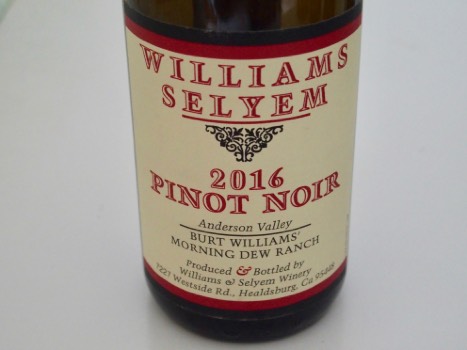 2016 Williams Selyem Burt Williams Morning Dew Ranch Anderson Valley Pinot Noir 13.6%, pH 3.51, TA 0.60, $85. Released fall 2018. Last vintage of the Morning Dew Ranch Pinot Noir by Williams Selyem as Burt Williams sold the Ranch in 2015. Aged 16 months in French oak barrels, 57% new 43% 1-year-old. Note: Williams Selyem wines (Pinot Noir, Chardonnay and Zinfandel) are allocated through a mailing list at www.williamsselyem.com. · Moderately light garnet color in the glass. This is an extremely easy-drinking wine showing exceptional harmony. The aromas of cherry and cardamom lead to a light to mid weight styled drink that is cherry-driven with added flavors of tobacco and licorice. The gossamer tannins make for a gracious mouthfeel and the finish is long and highly gratifying. Still fine when tasted the next day from a previously opened and re-corked bottle. I am sure this wine has at least another 6 good years. Score: 94
2016 LUMOS Temperance Hill Vineyard Eola-Amity Hills Willamette Valley Pinot Noir 13.5% alc., 145 cases, $45. Note Dai Crisp and his spouse PK McCovy started the LUMOS Wine Company in 2000. Since 1999, Dai has managed the Temperance Hills Vineyard, a 100-acre site in the Eola-Amity Hills AVA that is considered one of Oregon’s most esteemed vineyards. A tasting room, housed in an historic barn, is located in Wren, Oregon, 16 miles west of Corvallis. LUMOS wines are sold on the winery’s website at www.lumoswine.com. Prices are quite reasonable ($28-$45) considering the pedigree of the grapes sourced from Temperance Hill Vineyard. · Moderately dark garnet color in the glass. Black fruits are featured in this mid weight wine that sports excellent harmony. Since last reviewed in October 2018, this wine has gained considerable appeal. The core of dark berry and stone fruits so typical of this vineyard are vivid and saturating. The tannins have mollified since last tasted, and the wine aims to please. Score: 92
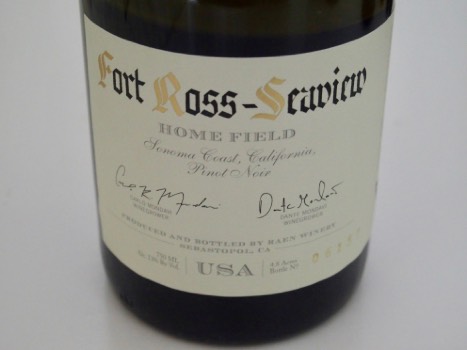 2017 RAEN Home Field Fort Ross-Seaview Sonoma Coast Pinot Noir 13.0% alc., $80. 4.8 acres, ancient marine soils at an elevation of 1500 feet. Whole cluster fermentations rely only on native yeasts. Clone 777. Aging is in neutral French oak barrels for 10 to 20 months depending on the site and vintage. The wines are bottled without fining or filtration. Note: RAEN (pronounced “rain” to remind us that wine was rain first and translated to Research in Agriculture and Enology Naturally)) winery, a partnership between winegrowers Carlo Mondavi and Dante Mondavi, focuses on Sonoma Coast Pinot Noir and Chardonnay. The three Pinot Noir wines offered: (1) Freestone Occidental Bodega Vineyard planted to clone 667, Pommard and a Calera selection ($95); (2) Fort Ross-Seaview Home Field Vineyard (going forward will be known as Sea Field) a site located just north of Jenner overlooking the Pacific Ocean ($80); the Sonoma Coast Royal St. Robert Cuvée (clones “828,”, 667, rVR1, Pommard and a Calera selection), a blend of fruit from the West Sonoma Coast ($60). Chardonnay is sourced from the Charles Ranch Vineyard located in the Fort Ross-Seaview AVA ($90). The wines are eagerly sought after and highly allocated to a mailing list at www.raenwinery.com. This young winery is proving to be Pinot Noir par excellence. · Moderate garnet color in the glass. an elegant, but very aromatic and flavorful wine offering aromas and tastes of ripe cherry, strawberry, exotic spice, wild herbs, and forest floor. This is one terrific wine to drink now that has excellent rapport between the fine-grain tannins and acidity. There is a clear whole cluster foundation that elevates this wine. I literally wanted to drink the whole bottle. Welcoming and amicable when tasted the following day from a previously opened and re-corked bottle. Score: 96
2017 Bien Nacido Estate Santa Maria Valley Chardonnay 12.6% alc., 251 cases, $40. The famed Bien Nacido Vineyard has been bottling Pinot Noir and Chardonnay under their Estate label since 2011. Grapes for this wine come from own-rooted, 45-year-old vines planted in shale with limestone outcroppings. This W Block of Chardonnay is the oldest block at Bien Nacido Vineyard, planted in 1973 to the original Wente clone. Whole cluster pressed, native fermentation, 100% malolactic fermentation, and aged sur lie 16 months in French oak barrels (25% new) and stainless steel. Bottled unfiltered. A tasting room for Bien Nacido and Solomon Hills Estate wines is located in downtown Los Olivos. Note: I did taste the 2016 Bien Nacido Estate Santa Maria Pinot Noir ($50) but cannot give it a recommendation since I found the oak barrel work to be overbearing. A tasting room for Bien Nacido and Solomon Hills Estate wines is located in downtown Los Olivos. Visit www.biennacidoestate.com. · Aromas of lemon, pineapple and straw with noticeable toast and nuttiness. Excellent restraint and edginess on the palate with flavors of grapefruit, lemon rind and lime shot through with an arrow of spirited acidity. This wine avoids the ripe fruit tropical flavors common in many California Chardonnays. An excellent value considering the pedigree of the grapes. Score: 92
2017 Littorai Hirsch Vineyard Sonoma Coast Pinot Noir 13.7% alc., $85. Sourced from vines that are farmed using organic and biodynamic principles. Littorai was one of the first purchasers of fruit from Hirsch Vineyard along with Steve Kistler and Burt Williams who first showed up together at Hirsch Vineyards in 1994. The three winemakers crafted startling good and age-worthy Pinot Noirs and spurred the notoriety of Hirsch Vineyards. The vineyard is planted to Pommard and Dijon clones and heritage selections including Swan, Calera and Mt Eden. This bottling includes 114, 777, Pommard clones and a Swan selection. Typically, Littorai wines are aged 16 months in French oak with about 25% new barrels. Note: The winery’s website is www.littorai.com. Littorai wines are sold only through an allocated mailing list. The wines are also available at many fine restaurants. · Moderately light garnet color in the glass. Aromas and flavors of mixed berries including strawberry framed by sandy tannins and bright acidity. Texturally of great interest but otherwise not exciting at this stage. Largely unchanged when re-tasted the following day from a previously opened bottle. Giving, but not yet generously, requiring patience. Score: 91
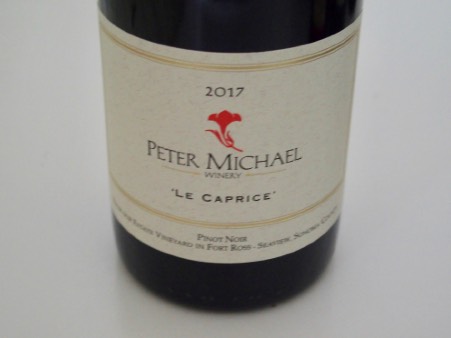 2017 Peter Michael ‘Le Caprice’ Fort Ross-Seaview Pinot Noir 14.3% alc., $130. Released April 1, 2019. This estate vineyard was planted in 2006 at 1,000-1,500 feet elevation on the first ridge-line from the coast to a suitcase clone of Pinot Noir. Soils are alluvial sediments, decomposed volcanic material and clay. The name of the vineyard is a reference to the capricious character of Pinot Noir. This bottling is typically the most fruit-forward of the three Peter Michael estate Pinot Noirs. Native yeast fermentation, aged 16 months in 50% new French oak barrels. The winemaker is Nicholas Morlet. Note: 3 wines are produced from the Peter Michael estate Seaview Vineyard: Le Caprice, Ma Danseuse and Clos du Ciel. A fourth Pinot Noir, ‘Le Moulin Rouge,’ is sourced from the Pisoni Vineyard in the Santa Lucia Highlands. The wines are allocated to a mailing list that is now full and interested consumers can join a waiting list at www.petermichaelwinery.com. The winery in Calistoga is available for tours and tasting to private members and waiting list members by appointment. · Moderately light garnet color in the glass. Intriguing aromas of black cherry, ripe strawberry, spice and redwood forest floor. Beautifully composed with exquisite balance, offering deep flavors of black cherry fruit that saturate every nook and cranny in the mouth. Very suave in texture in a medium weight style, with a mix of warn leather, floral and herbal undertones. Extremely satisfying now but displays the harmony that guarantees at least ten more years of drinking pleasure. Still righteous juice when tasted the following day from a previously opened and re-corked bottle. Score: 96
2018 Larkspur Dundee Oregon Pinot Noir 13.8% alc., $9.99 (with grocery store 6-pack purchase). Easily located in your favorite supermarket (Kroger, Fred Meyer, Fry’s etc.). Winemaker is Sarah Cabot who has several years of winemaking experience with Pinot Noir in the Willamette Valley. Vineyard sources and vinification details not available. · Moderately light garnet color in the glass. Welcoming aromas of black cherry and subtle oak spice. Silky in the mouth and very easygoing, with a core of black cherry fruit accented with a hint of spice. The tannins are well-proportioned, oak is well-mannered, and the dry, lip-smacking finish has a little length. This wine will not lead to an epiphany but will work as a satisfying everyday quaff. Score: 88
2018 Privé le nord Estate Chehalem Mountains Willamette Valley Pinot Noir 13.8% alc.,∼200 cases, $65. Le Nord is the north block of the Privé Vineyard at 600 feet elevation. 100% Pommard clone, 100% destemmed. The wine was aged 12 months in French oak barrels, 25% new. Note: Mark and Tina Hammond only produce 950 cases annually, specializing in Pinot Noir from their 2-acre vineyard, but also offering Syrah and Pinot Noir Port. Wines are available to a member’s list only. The Privé Vineyard was originally planted in 1980 and then grafted to Pommard clone in 1998 by the Hammonds after they acquired the vineyard in 1995. The label was launched in 2001. Other Pinot Noir bottlings include Le Sud (from the south block of the vineyard) and Joie De Vivre (a limited, reserve). Pricing varies with length of time one is on the member’s list. Etched magnums are available. Visits to the winery are welcome by appointment (minimum order of 6 bottles requested). Visit www.privevineyard.com. This is one of my favorite producers of Pinot Noir in the Willamette Valley. · Moderate garnet color in the glass. The wine is reserved upon opening, revealing its charms slowly over time in the glass. Aromas of Bing cherry, rose petal and spice tantalize. Middleweight in style, with flavors that replicate the aromas with a dusting of oak. Plush in the mouth, with balanced tannins, and an exceptionally long finish of black cherry goodness. Considerably more giving when tasted the following day from a previously opened and re-corked bottle. Best to give this beauty another 3 to 5 years in the cellar. Score: 93
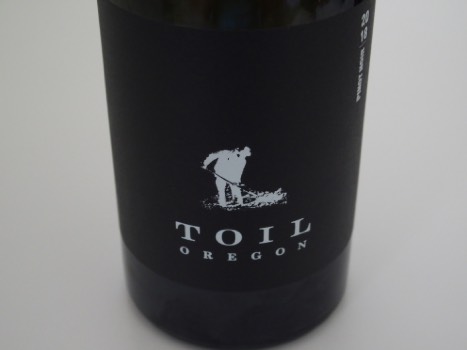 2018 Toil Oregon Willamette Valley Pinot Noir 14.0% alc., 755 cases, $50. Released spring 2020. Aged 11 months in French oak barrels, 32% new and 68% neutral. Note: This wine comes from Figgins Family Wine Estates that includes Leonetti, Figgins and Toil Oregon and is produced and bottled in Walla Walla Washington. The winemaker, Chris Figgins, is the son of Gary Figgins, the well-known winemaker who founded one of Washington’s cult wines, Leonetti Cellars. The inaugural wine was produced in 2012 from grapes sourced in the Willamette Valley. The new Toil Estate Vineyard is located in the Chehalem Mountains but has not yet produced a commercial crop.. Chris may be the first eastern Washington winemaker to offer a Willamette Valley Pinot Noir. The wines, that include a Chardonnay and Rosé, are sold through a mailing list at www.toiloregon.com. · Moderately light garnet color in the glass. Friendly aromas of cherry, strawberry, baking spices, and a hint of rose petal. Inviting freshness and vitality in a mid-weight style offering a satisfying core of black cherry fruit underlain with spice and subtle oak. Easy going in a forward drinking style. Score: 92
Summa Vineyard: A California Legacy Vineyard Continues to Please
There is really nothing we have come across that tastes like it.” Thomas Rivers Brown
Summa Vineyard was first planted in 1979 by Steve Young on a beautiful ridge-top site on Taylor Lane west of the town of Occidental and six miles inland from the Pacific coastline in the West Sonoma Coast. As a reference in time, in 1980, David Hirsch planted his first vines at Hirsch Vineyards in Cazadero located north of Summa Vineyard. Scott and Joan Zellar acquired the vineyard in 1982 and farmed it until Thomas Rivers Brown bought the Summa Vineyard in September 2010. The original 2 acres of vines included Pinot Noir, Chardonnay and Gewürztraminer but the latter two varieties were grafted over to Pinot Noir soon after the 1979 planting. The original Pinot Noir plantings have been a source of conjecture through the years because the Zellers either do not know or decline to disclose the plant material origins. Burt Williams, who crafted Pinot Noir from Summa Vineyard from 1988 to 1997, suspects the original vines are a Swan selection. In 1998, an additional 3 acres of Pinot Noir were added on resistant rootstock from old vine cuttings and these plantings are referred to as Summa Young Vines. In 2000, old vine cuttings were interplanted among the old vines. In 2005 and 2009, an additional 1.5 acres of Pinot Noir was planted adjacent the Zeller’s residence using old vine cuttings and known as the Driveway Block (New Vines). Since 2015, Thomas has removed underperforming, severely diseased, dead, and tractor damaged vines at the rate of 5 to 6 vines per year using a Calera selection. Thomas produced his first Summa Vineyard Pinot Noir in 2002 under the Rivers-Marie label when the Zellers offered him some grapes. This would prove to be a propitious decision for in 2004, Thomas tasted the 1988 Williams Selyem Summa Vineyard Pinot Noir (the inaugural Summa Vineyard release from Williams Selyem) and remarked afterwards, “I never tasted anything like it before from California. The first wines from Summa Vineyard were produced by the now-defunct Sea Ridge Winery in the late 1980s. Williams Selyem was unable to offer a Summa Vineyard Pinot Noir every vintage because yields could be minuscule. After the 1988 vintage, no 1989 or 1990 vintage was produced. In 1991, a total of one ton of grapes was harvested from the two acres which produced two barrels of wine. The cost of the grapes worked out to be $5,000 per ton when the farming costs for three years (two of which - 1989 and 1990 - yield no grapes) were considered. The 1991 Williams Selyem Summa Vineyard Pinot Noir was offered to the mailing list at $100 a bottle, the first California Pinot Noir to sell for triple digits. Burt figured that if people wouldn’t buy it, he and Ed would take it home and drink it. Williams said about the wine’s price, “C-note or c-none.” The wine sold out in three days. Williams Selyem released a Summa Vineyard Pinot Noir in 1993 (a combination with Coastlands Vineyard grapes was also bottled in this vintage), 1995 and 1997. In 1988-1990 and 1993-1995, declassified lots of Summa Vineyard grapes were sometimes a component of The Williams Selyem Sonoma Coast bottling. The 1995 Williams Selyem Summa Vineyard Pinot Noir was priced at $125 and again sold out within days. Ed Selyem that of all the grand cru Burgundies he had tasted over the previous decade there was not one that came close to this wine.
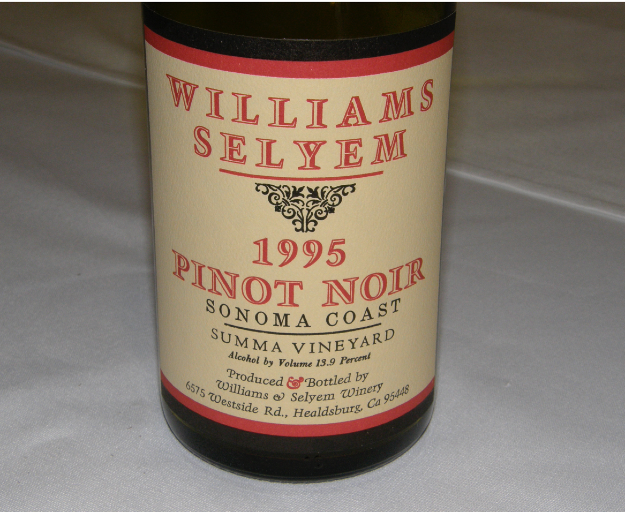 After Williams Selyem was sold in 1997, grapes from Summa Vineyard went to Mueller Winery (1998-2000), Brogan Cellars (1998-2006) and Littorai (2002-2008 using a combination of young and old vines). Since 2010, the vineyard has been a monopole exclusive to Rivers-Marie. Thomas produces a Summa Vineyard Pinot Noir (younger vines) and an “Old Vines” Summa Vineyard Pinot Noir. Declassified lots are blended into the Rivers- Marie Sonoma Coast bottling. The older aerial photo below shows the location of Summa Vineyard and the several other notable Pinot Noir vineyards nearby.
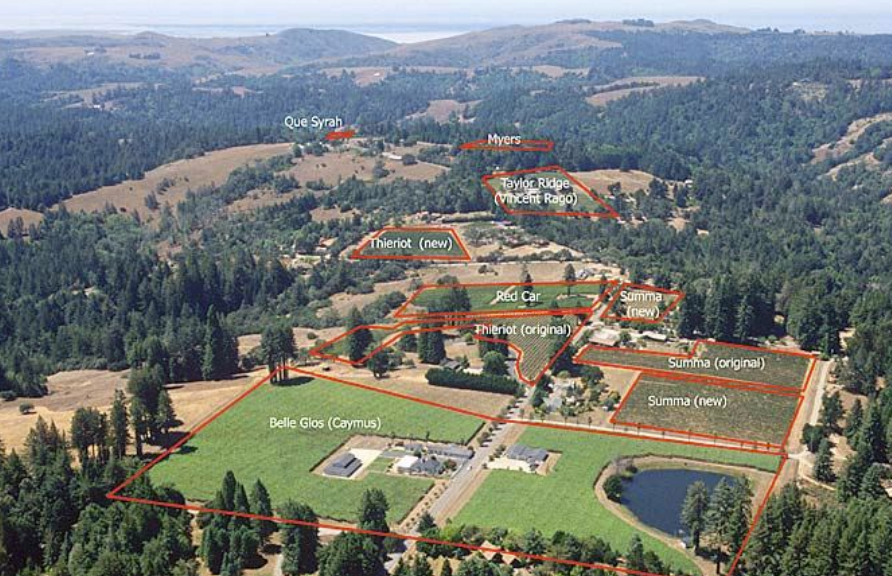 In the summer of 2012, I hosted a tasting of Summa Vineyard Pinot Noir wines from Rivers-Marie, Brogan Cellars, Mueller and Littorai and the results were posted in the PinotFile. Visit www.princeofpinot.com/article/ 1232/. I had a conversation with Thomas recently and he filled me in on the latest on Summa Vineyard. He told me, “Our primary focus out there is improving farming every year. We made great strides beginning in 2014. We’ve found that there is more vigor out there than we first thought and that the vineyard does better when it is actually holding a decent amount of fruit. We aren’t too afraid of really opening up the canopy early which keeps mildew pressure low with only a small trade-off of increased sun damage potential. We’ve learned the vineyard has no issue being dry-farmed, even during the drought or a really hot year like 2017. Any waterings the vineyard receives reflects only us panicking. The vineyard doesn’t really need to be tilled so we have gone to a much less intrusive no-till system, even leaving weed cover under the vines to pull up excess moisture. Every vine out there is its own vineyard so each plant in each block is trained differently based on the signals it puts out as to what it can handle. In the Old Vines, for instance, some vines seem a bit anemic so they may only carry one fruiting cane while others carry four and still push six-feet-plus canopies.”
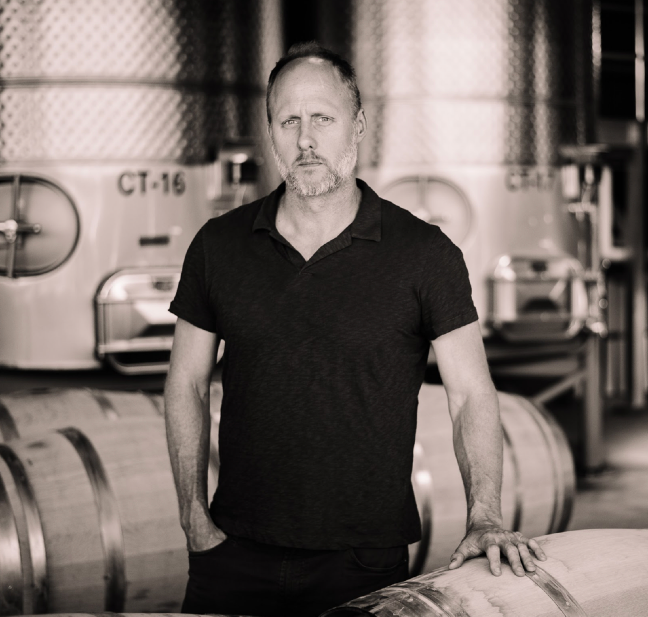 Two 2018 Rivers-Marie Summa Vineyard Pinot Noirs are reviewed here. Yields were substantial in 2018, almost 2 tons per acre for the Old Vines and just above 2.5 tons per acre for the regular vines. Vinification: no inoculation for primary or malolactic fermentation. Wines are generally on the skins 14 to 16 days, depending on the fermentation pace. 5-day cold soak. Depending on the vintage, wines see 1-2 punch downs a day during fermentation. Once wines are negative sugar by a hydrometer, tanks are sealed and tasted every day. Wines are pressed once the structure is desirable. Free-run and press wine are combined in tank and wine goes to barrel the following day. The Summa Vineyard Pinot Noirs spend 10 months in barrel, predominantly Remond, ranging from 50% new for Summa regular to 100% new for Summa Old Vines.
2018 Rivers-Marie Summa Vineyard Sonoma Coast Pinot Noir 13.5% alc., 325 cases, $60. Harvest Brix 23.1º. This “Baby Summa” comes from 20-year-old vines. Thomas feels this wine becomes more like the Old Vines bottling every year. For me, it is an excellent wine but relies a little bit more on fruit impact and less on complexity than the Old Vines Summa. · Dark garnet color in the glass. Highly expressive nose, offering scents of dark pie cherries, black raspberries, plum and a hint of vanilla and toast. Mid-weight plus in concentration, offering a charge of black cherry fruit that saturates the palate and holds up in generosity through an extended finish. A little more oak shows up on the nose and palate but dissipates with swirling. Gracious tannins make for easy approachability. Still fine when sampled the following day from a previously opened bottle. Score: 93
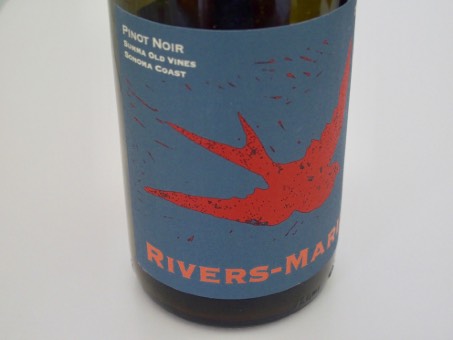 2018 Rivers-Marie Summa Vineyard Old Vines Sonoma Coast Pinot Noir 13.3% alc., 210 cases, $80. Harvest Brix 23.8º. · Moderately light garnet color in the glass. The enticing nose is a wonderland of aromas including cherry, spice, forest floor, and pine needles. The dreamy texture makes an impression immediately. Very enjoyable upon opening in a light to mid-weight style featuring a core of well-spiced redder fruits. A stellar wine with engaging freshness and gossamer tannins, finishing unusually long. There is something about this wine that is hard to put into words but you know it is special. Perhaps it is the fact that it offers complexity rather than brute sap. Most certainly, it is the forty-year-old vines speaking. In any case, this beauty has the balance to age for many years and I am sure it will bring many oohs and aah down the line. Still magnificent when tasted the following day from a previously opened bottle. Score: 95
Another Summa Vineyard oldie recently tasted:
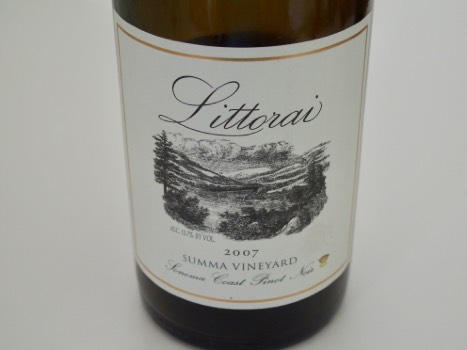 2007 Littorai Summa Vineyard Sonoma Coast Pinot Noir 13.7% alc., $80. Cellared at 55º since release. I have tasted every vintage of Littorai Summa Vineyard Pinot Noir from 2002-2008 and the wines have been consistently top-shelf. The reviews are available in the PinotFile. Note: the 2008 vintage was also sampled. That wine is still packed with fruit but is smoke tainted caused by the devastating California wildfires. One’s enjoyment will depend on one’s tolerance for smoke taint. N/R. · Moderately dark garnet with slight bricking at the rim. Terrific nose infused with aromas of black cherry, exotic spices, dried herbs, tobacco and old cigar box. Velvety and comforting in the mouth featuring mid weight flavors of darker cherry and berry with an aged patina. Oak is not in the picture. The wine still presents heady fruit and holds up beautifully in the glass when sampled over the course of an hour. A marvelous, well-aged Pinot Noir that should be drunk now. Score: 94
Wines Recently Submitted for Review
Fulcrum Winery, Sonoma, CA2018 was a superb vintage with both high yields and excellent quality. The 2018 growing season was marked by a cool spring, warm summer, and a long, cool harvest with only spots of rain. Pinot Noir grapes were allowed to hang on the vines well into October.
2018 Cloisonné Sonoma Coast Pinot Noir 14.1% alc., 707 cases, $24. A Napa-based negotiant producing small lots of wines from growing areas in California. Available for tasting in the Fulcrum Tasting Room and distributed retail nationally. 100% de-stemmed grapes, Aged in French oak barrels. · Moderate garnet color in the glass. Aromas of black cherry, dark red berry, peppery herbs and vanilla. Better on the palate in a mid weight style, offering a charge of black cherry, cola and anise flavors backed by gentle tannins. A reliable quaff that shows some length on the spirited, spicy finish. Score: 88
2018 On Point Winemaker’s Selection North Coast Pinot Noir 14.2% alc., 183 cases, $39. A blend of grapes from Gap’s Crown, Hogan’s Run and Conzelman vineyards. Aged 11 months in French oak barrels, 24% new. · Moderately light garnet color in the glass. Aromas of black raspberry, cherry, vanilla and mushroom earthiness. rise up from the glass. Well-endowed with juicy flavors of spicy dark red cherry and blackberry with a modicum of oak in the background. Nicely balanced tannins and forthright acidity with a lip-smacking finish. Score: 90
2018 Fulcrum Gap’s Crown Vineyard Petaluma Gap Pinot Noir 14.3% alc., 214 cases, $70. Clones “faux 828” and 667. Aged 11 months in French oak barrels, 40% new. Bottled unfined and unfiltered. · Moderately dark garnet color in the glass. A relatively ripe, boisterous and full-bodied wine that makes a big impression. The aromas and flavors of darker berry fruits grab attention, but the sappy fruit is not summatré. The fruit cloaks the supportive tannins so the mouthfeel is sleek and velvety. A typical Gap’s Crown Vineyard Pinot Noir. Score: 93
MonksGate Vineyard, Yamhill-Carlton, ORA small family-owned and operated winery located in Carlton, Oregon, producing Pinot Noir and Riesling from a 20-acre estate vineyard planted from 2000 to 2007. There is an interesting back story to this winery. The name, MonksGate, was derived organically when Ron and Linda Moore, unpacking to move to their new property, saw Monks from the nearby Trappist Abbey walking out of the woods behind what is now the winery’s tasting room. The property at the time was covered in 20 acres of overgrown fir trees that were planted to keep the property in Ag tax deferral, along with scrub oak and blackberry bushes. When the Monks became concerned that the property would be fenced, Ron offered to put in a gate for them. He did, they have made good use of it, and a name was born! From 2000-2014 the winemaker was distinguished veteran winemaker Laurent Montalieu. Early on, the wines were produced as a hobby and poured for festivals and big weekends. When their daughter, Rebecca, took over the label in 2015, she also took control of the vineyard and hired Drew Voit as winemaker. Rebecca has taken a significant role in the cellar alongside Drew, grown production, improved the property and developed a wine club. The estate vineyard is planted to Wädensvil 2A, Pommard, 777, 667 and 115. Soils are marine sedimentary (Willikenzie series) with fingers of volcanic (Jory series) as the property is located on the backside of the Dundee Hills. Visit www.monksgate.com.
2019 MonksGate Vineyard North Block Yamhill-Carlton Willamette Valley Dry Rosé of Pinot Noir 12.3% alc.,pH 3.09, 198 cases, $22. Released February 2020. 100% Pommard. Whole cluster gently pressed. Aged 4 months in stainless steel. · Light salmon color in the glass. Nicely perfumed with scents of fresh strawberry and red raspberry. The flavors of blood orange, red berry and watermelon are bright and satisfying. Bone dry, with sprightly acidity, very modest tannins and a quenching finish. Score: 90
2017 MonksGate Vineyard Yamhill-Carlton Willamette Valley Pinot Noir 14.3% alc., pH 3.61, 425 cases, $38. Released September 2019. 30% Pommard, 23% 667, 27% Wädenswil, 20% 115. Aged 10 months. · Light garnet color in the glass. The nose shows some volatile acidity upon opening that resolves when tasted several hours after opening. Light in weight, with aromas of red cherry and dried herbs, and flavors of cherry and herbal oak. A bit shallow on the mid palate with moderately firm tannins. Score: 88
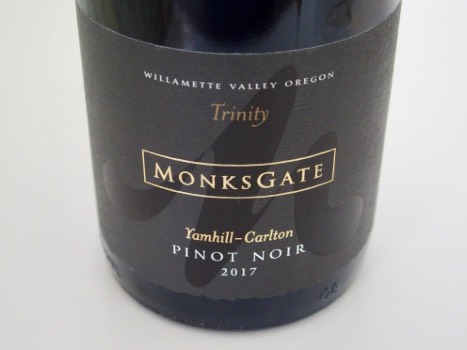 2017 MonksGate Vineyard Trinity Yamhill-Carlton Willamette Valley Pinot Noir 14.3% alc., pH 3.58, 194 cases, $50. Released September 2019. A limited production barrel selection. 50% 777, 38% Pommard and 12% 667. Aged 10 months. · Moderately light garnet color in the glass. Shy, but pleasing aromas of dark red cherries and berries, and enticing riffs of rose petal and spice. A middleweight style that is juicy and bright, offering a chewy core of dark Bing cherry fruit. Adroit winemaking with a light touch of oak, gracious tannins and a satisfying, moderately long finish. Score: 92
Phelps Creek Vineyards, Columbia Gorge, ORThe winemaker at Phelps Creek is Alexandrine Roy, a fourth generation winemaker at Domaine Marc Roy in Gevrey-Chambertin. The Cuvée Alexandrine bottling is a winemaker’s barrel selection from the estate vineyard. Pommard and Dijon clones. Native yeast fermented, aged in French oak barrels, about 25% new. Visit www.phelpscreekvineyards.com.
2015 Phelps Creek Cuvée Alexandrine Columbia Gorge Oregon Pinot Noir 13.9% alc., 245 cases, $54. · Moderately dark garnet color in the glass. The nose opens slowly to reveal appealing aromas of earthen blackberries. Both black cherry and blackberry fruits and botanical elements for the mid-weight core of this wine that exhibits noticeable tannins creating a modicum of astringency on the finish. Considerably more appealing when sampled the following day from a previously opened and re-corked bottle with more fruit to the forefront and tannins to the rear. Score: 91
2016 Phelps Creek Cuvée Alexandrine Columbia Gorge Oregon Pinot Noir 13.9% alc., 264 cases. · Moderate garnet color in the glass. A complex nose offers scents of cherry, earthy flora, and oak-driven spice and toast. Charming black cherry and black raspberry fruit flavors in a middleweight style backed by noticeable oak. Supportive and integrated tannins with a sleek and silky mouthfeel and a grand finish that leaves an impression. Score: 92
2017 (not produced due to fires)
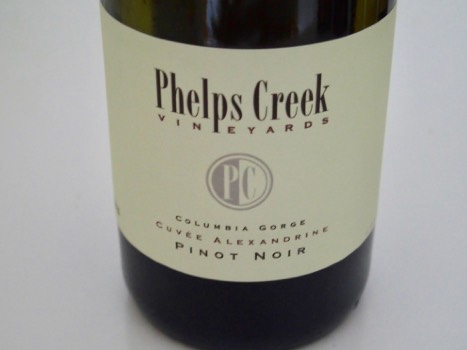 2018 Phelps Creek Cuvée Alexandrine Columbia Gorge Oregon Pinot Noir Unreleased, unlabeled bottle. · Moderately light garnet color in the glass. Alluring aromas of black cherry and mushroomy earth. Light to mid-weight in sap and quite fruit forward, displaying flavors of purple grape, cherry and spice. Excellent harmony with notable elegance, and a substantial grip of black cherry fruit that persists on the lengthy finish. More desirable when sampled the following day from a previously opened bottle with more prancing fruit engaged with very fine-grain tannins and bashful oak. Score: 94
More Wines
2017 VIE North Coast Pinot Noir 14.2% alc., pH 3.66, TA 0.62, 150 cases, $35. Released October 2019. Winemaker Bryan Kane seeks out small vineyards using organic and sustainable farming practices in the North Coast including Los Carneros, Sonoma Coast the Anderson Valley. Indigenous yeast fermentation. Aged 14 months in French oak barrels, 17% new. · Light orange-red color in the glass. The nose leads with an oak-kissed red cherry aroma. Easygoing, with gossamer tannins, featuring red and blue berry flavors in a light-to-mid-weight style. The wine develops more charm and interest over time in the glass although it was less appealing when tasted the following day from a previously opened and re-corked bottle, so probably not a cellar candidate. Score: 89
BriefsPonzi Vineyards Celebrates Its 50th Anniversary with a Memoir “Pinot Girl,” released May 6, 2020 is an intimate memoir of Anna Maria Ponzi, the daughter of one of Oregon’s earliest wine families. Dick and Nancy Ponzi were among the first to grow and produce Pinot Noir in the Willamette Valley. Anna Maria, one of the three children in the family, tells the story of a young girl who grew up among the vines and how a family that were neither farmers, winemakers or businesspeople, developed into a world-renowned wine business. $17.95 from the usual sources.
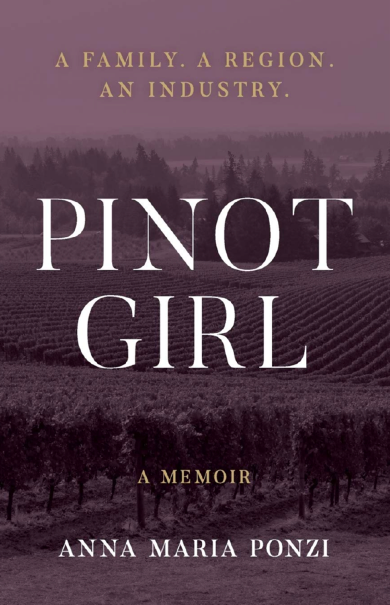 Alcohol-related Facial Flushing Linked to Alzheimer’s The Oriental Flushing Syndrome occurs in hundreds of millions of Chinese that have a mutation in the gene for aldehyde-dehydrogenase-2 isoenzyme, ALDH2, needed to metabolize ingested alcohol. The mutation is rare outside of East Asian populations, except in the Polynesian people. Having the gene that impairs alcohol metabolism could increase a person’s risk of developing Alzheimer’s disease. Stanford scientists recently found that cells from Alzheimer’s patients contained more free radicals and toxic by-products than cells from control groups did, leading to a viscous cycle of cell damage with neurodegenerative consequences. Adding alcohol increased the level of free radicals in all cells, but more so in those with the alcohol-related mutation. Chinese with the ALDH2 mutation are also at a significantly higher risk for esophageal and oropharyngolaryngeal cancers. So, although the potential market for wine sales among China’s newly affluent consumers is large, up to half of the population who suffer from the Oriental Flushing Syndrome are unable or unwilling to drink wine. The avoidance of wine for health reasons makes this imperative. International Pinot Noir Celebration Postponed The International Pinot Noir Celebration (IPNC) has had to be postponed until July 23-25, 2021 due to the uncertainty posed by the novel corona virus. Those holding tickets for the 2020 IPNC have been automatically updated for the new date in 2021. Visit www.ipnc.org or follow on twitter @IPNC or Instagram @ipnc-pinot for updates. Pegasus Winery Lightens Up the Restroom One of my readers, who is a fan of Pegasus Winery Pinot Noir, copied me a photo of a sign above the urinal at the winery located in Christchurch, New Zealand.
 Benovia Winery Honors Veterans with Release of 2018 Liberation Pinot Noir The winery has just released the 2018 vintage of its popular Liberation Pinot Noir. The wine is available for $50 per bottle and $10 from each purchase will be donated to the Gary Sinise Foundation which honors and supports defenders, veterans, first responders, their families and those in need. In addition, Chairman Joe Anderson will contribute an extra $5 through his Anderson Family Foundation to the Gary Sinise Foundation. The Liberation Pinot Noir was originally created to mark the 75th anniversary of D-Day and the 2018 is now the third vintage. Anderson owns a WWII-era airplane called The Spirit of Benovia, that he and his pilot flew to Normandy last year to mark the 75th anniversary of D-Day. On Memorial Day this year, The Spirit of Benovia will join 17 other historic planes in formation, as they honor veterans and healthcare workers in Southern California. A dramatic label was created for Liberation Pinot Noir, designed by pilot and artist Craig Kodera. The label depicts an airborne D-Day squad. Benovia’s 2018 Liberation Pinot Noir is a blend created by winemaker Mike Sullivan. The grapes come from an estate property near the town of Freestone in the Sonoma Coast AVA. can be purchased on the winery’s website at www.benoviawinery.com.

Drinking Older Domestic Pinot Noir Has Taught Me A Few Lessons
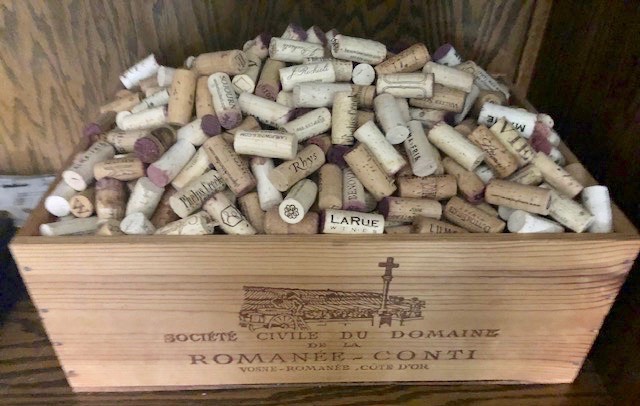
Only quality Pinot Noir evolves into something more interesting than it was in its youth. Wines that are of poor quality when young will not be expected to improve simply by cellaring them - a wine cellar is not a wine hospital. Poorly balanced Pinot Noir may show exaggeration of elements that were not harmonious upon release, such as oak and alcohol as the fruit fades. In addition, faults in wine may exaggerate over time. Lessons learned:
1. Decanting is always advisable unless the Pinot Noir is over ten years of age. I find that Pinot Noir almost never shows its true character immediately upon pulling the cork. Remove the cork in the morning on a day you plan to drink the wine with dinner. Decant it and put it back in the bottle with a funnel and re-cork until dinner. 2. I believe many winemakers feel their Pinot Noir wines are best drunk in the 5 to 7-year post-vintage range and I agree with this dictum as domestic Pinot Noir will not usually improve beyond this time. Aging beyond seven years is only an option for gamblers or those who delight in tertiary characters. 3. That said, I have found more surprises than disappointments after opening well-aged bottles recently and many wines are still superb 10 to 15 years after the vintage. I must qualify this by pointing out that I am only opening ultra-premium examples of Pinot Noir stored since release at 55º. 4. Old corks are fragile and may be dried out so use caution and patience in extracting them. 5. Always have a backup wine because you never know. No one can predict Pinot Noir’s apogee. Do not be encumbered by worrisome thoughts about how long to cellar a domestic Pinot Noir. Just pop the cork when you feel like drinking the wine. It is the gospel truth that it is better to drink a domestic Pinot Noir too early than too late. Better to revel in the joy of youthfulness than the decrepitude of old age! |